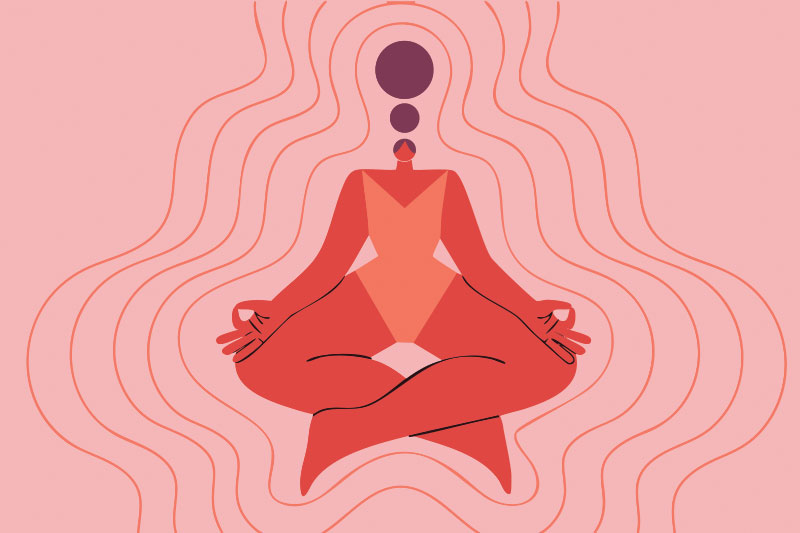Holistic Health 101
A primer on practices to nurture your mind, body and spirit for complete wellness

The word “wellness” often gets a bad rap.
We lump it into the ever-growing pile of unscientific woo-woo with jade eggs (for the unfamiliar, Google this along with actress and lifestyle guru Gwyneth Paltrow’s name) or sleeping with onions on your feet. But wellness simply means being in a state of good health. And who doesn’t want that? As Western science begins to catch up with Eastern, indigenous and folk practices, we are learning that good health is about more than physical vitality. The fitness of our minds and spirits is not only connected to physical health, but also essential to our overall well-being. In a region that embraces Creole and Cajun traiteurs, or faith healers, the interconnection of mind, body and spirit is not a foreign concept, but some practices that are gaining the attention of the medical community and becoming more mainstream might still be a bit unfamiliar. Yoga is one of those practices and it’s about much more than the pretzel-like poses most of us have come to recognize.
As a certified yoga teacher and Ayurvedic nutrition counselor, I often get asked about my practices and field requests for resources. Generally, I start with yoga asana, or the physical practice of yoga, because by now most of us are familiar with it and have a studio in our neighborhood, have taken a class or know someone who swears by it. But yoga is a philosophy and an ancient whole-health system of living that originated in India thousands of years ago; physical practice is merely one aspect. Without getting too technical, there are eight “arms” of yoga, but here we’ll focus on only four to get you started. I’ll also offer a few local and online resources so you can slowly add the practices that resonate into your wellness toolbox.
Let’s Get Physical: Yoga Asana
According to Johns Hopkins Medicine, yoga asana can increase strength, balance, flexibility, mobility, stress, pain relief, sleep, heart health, energy and moods. The military and medical communities have both begun integrating yoga asana into health and wellness programming and physical and mental health therapies. The “poses” or “shapes” in yoga are not only designed to stretch, lengthen and strengthen, but also to help us increase the awareness of our bodies, so we notice when something is “off” and can be proactive about finding balance through lifestyle changes or the right treatments and therapies. A yoga asana practice can also have a spiritual element, especially given the tradition it originated in considered it a way to commune with the divine. Whatever your faith tradition, however, feel free to incorporate spirituality into your practice. Yoga isn’t just for the already strong and flexible. It’s truly for everybody and every body. From chair (or even bed) yoga to hot yoga, there is something for everyone. Popular styles include Vinyasa, Iyengar, Hatha, Kundalini, Bikram, Ashtanga and Yin, but there are others as well, so check out your local studio and experiment with styles and teachers to find the best fit for your level of ability and comfort zone.
Just Breathe: Pranayamic Yoga
Our modern lives with constant demands on our attention via devices, divisive politics, fast-paced work and social lives, traffic woes, caregiving young children and parents — well, you get the idea —are not conducive to relaxation. This can lead to our sympathetic nervous systems staying in a state of constant fight or flight, leaving us in a vicious cycle of anxiety, insomnia and fatigue and on the road to long-term health issues like high blood pressure and heart disease if left unchecked. According to Harvard Health, breath control, also known as breathwork or pranayama, can help by activating our parasympathetic nervous system, or rest and digest mode. Yoga provides a long list of pranayamic breathing techniques to help with a variety of issues, but the common denominator is controlling the breath. By simply focusing on the breath and learning how to breathe fully through the diaphragm (or belly breathing), we can change the way we engage with stress and our daily lives. Full and complete breath has myriad benefits, including oxygenating cells and strengthening the lungs and the immune system. Breathwork is often incorporated into yoga asana, so a great way to learn is to take a yoga class. There are also a wealth of apps (see the sidebar) and online articles and video tutorials through Yoga International, Yoga Journal and the Kripalu Center for Yoga & Health, to name a few.
Meditate for Health: Yoga Dharana
If there is a meditator in your life, chances are they’ve shared the benefits with you and it sounds too good to be true. While meditation, or yoga dharana, isn’t a panacea, it can have remarkable benefits. The list from the Mayo Clinic is long and includes focus, relaxation, better sleep, improved mood, lower stress, less fatigue, changes in negative thought patterns, lower anxiety and depression, improved health and help in managing chronic pain, asthma, cancer, heart disease, high blood pressure, sleep problems, digestive issues and post-traumatic stress disorder. OK, on second thought, maybe meditation is a panacea. What are you waiting for? A misnomer about meditation is that it means clearing your mind. That’s impossible. Rather, it’s about noticing when your mind is wandering. Simply focus on or count your breath, notice when you start thinking about your to-do list or what to have for lunch and redirect your attention back to the breath. Find guidance using the apps in the sidebar and practice, practice, practice.
Eat Like a Yogi: Food as Medicine
Yoga has a sister science called Ayurveda, which is a 3,000-year-old medical system. An integral element of Ayurveda is nutrition, or the sattvic diet. This way of eating focuses on fresh, whole foods, easing digestion and a philosophy that food can be both medicine and poison, depending on how and what you eat. Those familiar with anti-inflammatory diets will see similarities and in fact, some anti-inflammatory diets are inspired by The Ayurvedic way of eating. There are limitless options online for Ayurvedic counseling and treatment. A great resource is the Ayurvedic Institute in Asheville, North Carolina. In Lafayette, Mary Ann Smith, in addition to being co-owner and instructor at Mantra Yoga, is an Ayurvedic practitioner, which means she can guide clients in lifestyle practices such as diet, as well as prescribe herbs and supplements for treatment or overall health and wellness. There are also Ayurvedic doctors and Ayurvedic nutrition counselors online and in the region, so if you plan to seek services, be sure to do your research and learn what each one is qualified to do (or not do) in the scope of their practice.
The Journey Starts with Baby Steps
Yoga, whichever style or “arm” you choose, is all about moderation, so start small and pick only one of the above. Once you get into a good routine with a new practice, add one more and so on. As always, check with your doctor before changing your diet or exercise routine, but don’t be surprised if when you tell doc about your new yoga practic, they give you a high five.
Podcast
“The Pulse with MAPI.com” hosted by Śankari Wegman, Ph.D., an Ayurvedic clinician, lecturer and health coach.
“Everyday Ayurveda & Yoga at Hale Pule” with founder Myra Lewin, author, Ayurvedic practitioner, Ayurveda yoga therapist, Yoga Alliance certified yoga teacher and master yogini.
Apps
Headspace
Great for beginning meditators, Headspace teaches users how to meditate. It was created by a healthcare company that specializes in mental health and uses research-based tools to help people improve metal health and wellness.
Insight Timer
Get pre-recorded and live guided meditation, breathwork, yoga, soundbaths, classes and workshops from teachers around the globe.
Calm
Daily guided meditation, movement, breathing, music and sleep offerings, as well as courses from notable teachers with some of your favorite actors voicing the sleep stories.
Books

“Yoga and the Quest for the True Self”, by Stephen Cope
This book will teach you what yoga is all about and how it can help you live more authentically.

“Living Ayurveda: Nourishing Body and Mind through Seasonal Recipes, Rituals, and Yoga” , by Claire Ragozzino
An incredible resource for beginners and seasoned yoga practitioners, this book takes the reader through a year of Ayurvedic living with guides, resources, recipes, gorgeous photos and practical wisdom.

“Perfect Health: The Complete Mind/Body Guide”, by Deepak Chopra, M.D.
This book breaks down the art and science of Ayurveda through the lens of this ancient medical system and current Western research and medical science.


